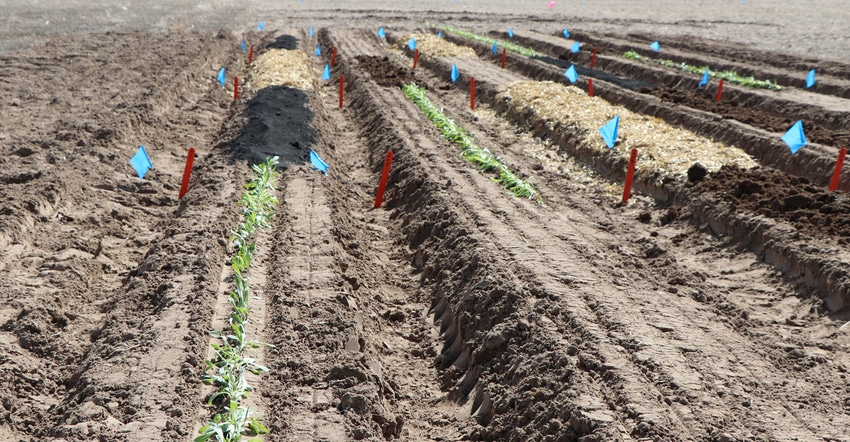May 27, 2019

By David Ostdiek
Crops growing in plots at the University of Nebraska's Panhandle Research and Extension Center in Scottsbluff this summer will include the usual assortment of dry beans, corn, sugarbeets, peas and various alternative crops. In their midst, one small plot has rows of plants that look like the dandelions in local yards.
In fact, they are dandelions of a different type. Their roots produce rubber, and this test plot is part of a multistate collaborative project to see if rubber and biofuels can be grown and processed from dandelions in the U.S. The project is called Biofuel and Rubber Research and their Agricultural Linkages (BARRAL).
According to the project proposal, this effort aims to develop rubber dandelions (or TK for the plant’s scientific name, Taraxacum kok-saghyz) as an alternative to help meet the country’s need for both transportation biofuels and a domestic supply of natural rubber.
Inulin and biomass from the plant can be converted to biofuel, and the natural rubber produced from the plant has qualities almost identical to the rubber extracted from rubber trees and can be used for a variety of applications, including technically sophisticated, high-performance automotive tires.
The BARRAL consortium is led by Ohio State University and has a goal of overcoming potential barriers to commercialization of rubber dandelion. Barriers include:
• mechanical operations, such as planting and harvesting
• agronomic practices used to grow the crop in certain regions
• handling, storage and bioprocessing of rubber and biofuel from the dandelions
• larger effects that a rubber-producing industry might have on the northern U.S.
The three-year project is funded by a grant for $2 million, funded jointly by the Department of Energy and USDA. It has several components, including plant breeding, processing (turning the dandelion roots into rubber) and agronomics.
At the Panhandle center, the focus is on the agronomic element, and it is led by Nevin Lawrence, Nebraska Extension integrated weed management specialist.
One-fourth of the $2 million total funding goes to the University of Nebraska. The grant will pay for labor, equipment and materials.
Two other specialists from the Panhandle center also will be involved. Bijesh Maharjan, Extension soil and nutrient management specialist, and Xin Qiao, Extension irrigation and water management specialist, will co-coordinate the irrigation and fertility study.
Research in Scottsbluff will focus on:
• what equipment and methods can be used to establish a crop
• the optimal length of growing season
• the irrigation and fertilizer requirements
• how to improve weed control
• optimal harvest methods
So far, the dandelion plants are proving difficult to get started in the region’s light soils and windy spring conditions, Lawrence said. Several dandelion plots have been seeded at the Panhandle center to compare various soil treatments.
Some rows are covered with manure, some with straw and some with char, a coal combustion residue created as a byproduct of refining sugarbeets at regional sugar plants.
Rubber dandelion could be a new source of natural rubber in the event of a sudden global shortage. Currently, all commercially available natural rubber is produced from rubber trees in tropical countries, more than 90% in southeast Asia.
The U.S. imports 1.5 million tons of natural rubber per year for manufacturing, and vast quantities of finished goods. Currently, there is a global shortfall in natural rubber production, but as other countries develop, so will global demand.
This puts the U.S. and other importing countries at risk of high prices or unavailability of natural rubber.
According to Lawrence, the project got its start with Ohio State University biochemist Katrina Cornish. Cornish was studying the dandelions but found that they would not grow well in heavier soils typical of Ohio, Lawrence said, but that a lighter, sandier soil might work.
In addition to the Nebraska Panhandle, agronomic research is being conducted at Oregon State University and Ohio State University, Lawrence said.
To date, rubber from dandelions hasn't been commercially grown and processed, but Ohio State has contracted with an Ohio grower to produce a small amount that has been processed on a small scale. It was used to manufacture tires and other products that match the quality of existing rubber, Lawrence said.
Lawrence cautions that the dandelions will not become a major alternative crop for Panhandle growers anytime soon. In addition to agronomic hurdles, there are questions about whether it will be possible to grow and produce rubber on a large scale that matches the quality of existing rubber products.
Ostdiek is communications specialist at the Nebraska Panhandle Research and Extension Center.
Source: UNL CropWatch, which is solely responsible for the information provided and is wholly owned by the source. Informa Business Media and all its subsidiaries are not responsible for any of the content contained in this information asset.
You May Also Like




